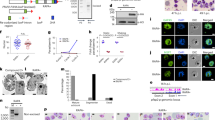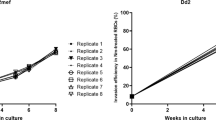Abstract
Mono-allelic expression of gene families is used by many organisms to mediate phenotypic variation of surface proteins. In the apicomplexan parasite Plasmodium falciparum, responsible for the severe form of malaria in humans, this is exemplified by antigenic variation of the highly polymorphic P. falciparum erythrocyte membrane protein 1 (PfEMP1)1,2. PfEMP1, encoded by the 60-member var gene family3,4,5,6, represents a major virulence factor due to its central role in immune evasion and intravascular parasite sequestration. Mutually exclusive expression of PfEMP1 is controlled by epigenetic mechanisms involving chromatin modification and perinuclear var locus repositioning7,8. Here we show that a var promoter mediates the nucleation and spreading of stably inherited silenced chromatin. Transcriptional activation of this promoter occurs at the nuclear periphery in association with chromosome-end clusters. Additionally, the var promoter sequence is sufficient to infiltrate a transgene into the allelic exclusion programme of var gene expression, as transcriptional activation of this transgene results in silencing of endogenous var gene transcription. These results show that a var promoter is sufficient for epigenetic silencing and mono-allelic transcription of this virulence gene family, and are fundamental for our understanding of antigenic variation in P. falciparum. Furthermore, the PfEMP1 knockdown parasites obtained in this study will be important tools to increase our understanding of P. falciparum-mediated virulence and immune evasion.
This is a preview of subscription content, access via your institution
Access options
Subscribe to this journal
Receive 51 print issues and online access
$199.00 per year
only $3.90 per issue
Buy this article
- Purchase on Springer Link
- Instant access to full article PDF
Prices may be subject to local taxes which are calculated during checkout




Similar content being viewed by others
References
Biggs, B. A. et al. Antigenic variation in Plasmodium falciparum. Proc. Natl Acad. Sci. USA 88, 9171–9174 (1991)
Roberts, D. J. et al. Rapid switching to multiple antigenic and adhesive phenotypes in malaria. Nature 357, 689–692 (1992)
Su, X. Z. et al. The large diverse gene family var encodes proteins involved in cytoadherence and antigenic variation of Plasmodium falciparum-infected erythrocytes. Cell 82, 89–100 (1995)
Smith, J. D. et al. Switches in expression of Plasmodium falciparum var genes correlate with changes in antigenic and cytoadherent phenotypes of infected erythrocytes. Cell 82, 101–110 (1995)
Baruch, D. I. et al. Cloning the P. falciparum gene encoding PfEMP1, a malarial variant antigen and adherence receptor on the surface of parasitized human erythrocytes. Cell 82, 77–87 (1995)
Gardner, M. J. et al. Genome sequence of the human malaria parasite Plasmodium falciparum. Nature 419, 498–511 (2002)
Duraisingh, M. T. et al. Heterochromatin silencing and locus repositioning linked to regulation of virulence genes in Plasmodium falciparum. Cell 121, 13–24 (2005)
Freitas-Junior, L. H. et al. Telomeric heterochromatin propagation and histone acetylation control mutually exclusive expression of antigenic variation genes in malaria parasites. Cell 121, 25–36 (2005)
Chen, Q. et al. Developmental selection of var gene expression in Plasmodium falciparum. Nature 394, 392–395 (1998)
Scherf, A. et al. Antigenic variation in malaria: in situ switching, relaxed and mutally exclusive transcription of var genes during intra-erythrocytic development in Plasmodium falciparum. EMBO J. 17, 5418–5426 (1998)
Jensen, A. T. et al. Plasmodium falciparum associated with severe childhood malaria preferentially expresses PfEMP1 encoded by group A var genes. J. Exp. Med. 199, 1179–1190 (2004)
Deitsch, K. W., del Pinal, A. & Wellems, T. E. Intra-cluster recombination and var transcription switches in the antigenic variation of Plasmodium falciparum. Mol. Biochem. Parasitol. 101, 107–116 (1999)
Voss, T. S. et al. Genomic distribution and functional characterisation of two distinct and conserved Plasmodium falciparum var gene 5′ flanking sequences. Mol. Biochem. Parasitol. 107, 103–115 (2000)
Voss, T. S., Kaestli, M., Vogel, D., Bopp, S. & Beck, H. P. Identification of nuclear proteins that interact differentially with Plasmodium falciparum var gene promoters. Mol. Microbiol. 48, 1593–1607 (2003)
Deitsch, K. W., Calderwood, M. S. & Wellems, T. E. Malaria. Cooperative silencing elements in var genes. Nature 412, 875–876 (2001)
Gannoun-Zaki, L., Jost, A., Mu, J., Deitsch, K. W. & Wellems, T. E. A silenced Plasmodium falciparum var promoter can be activated in vivo through spontaneous deletion of a silencing element in the intron. Eukaryot. Cell 4, 490–492 (2005)
Calderwood, M. S., Gannoun-Zaki, L., Wellems, T. E. & Deitsch, K. W. Plasmodium falciparum var genes are regulated by two regions with separate promoters, one upstream of the coding region and a second within the intron. J. Biol. Chem. 278, 34125–34132 (2003)
Horrocks, P., Pinches, R., Christodoulou, Z., Kyes, S. A. & Newbold, C. I. Variable var transition rates underlie antigenic variation in malaria. Proc. Natl Acad. Sci. USA 101, 11129–11134 (2004)
O'Donnell, R. A. et al. A genetic screen for improved plasmid segregation reveals a role for Rep20 in the interaction of Plasmodium falciparum chromosomes. EMBO J. 21, 1231–1239 (2002)
Ralph, S. A., Scheidig-Benatar, C. & Scherf, A. Antigenic variation in Plasmodium falciparum is associated with movement of var loci between subnuclear locations. Proc. Natl Acad. Sci. USA 102, 5414–5419 (2005)
Navarro, M. & Gull, K. A pol I transcriptional body associated with VSG mono-allelic expression in Trypanosoma brucei. Nature 414, 759–763 (2001)
Shykind, B. M. Regulation of odorant receptors: one allele at a time. Hum. Mol. Genet. 14 (suppl. 1), R33–R39 (2005)
Trager, W. & Jensen, J. B. Cultivation of malarial parasites. Nature 273, 621–622 (1978)
Beeson, J. G. et al. Plasmodium falciparum isolates from infected pregnant women and children are associated with distinct adhesive and antigenic properties. J. Infect. Dis. 180, 464–472 (1999)
de Koning-Ward, T. F., Waters, A. P. & Crabb, B. S. Puromycin-N-acetyltransferase as a selectable marker for use in Plasmodium falciparum. Mol. Biochem. Parasitol. 117, 155–160 (2001)
Mamoun, C. B., Gluzman, I. Y., Goyard, S., Beverley, S. M. & Goldberg, D. E. A set of independent selectable markers for transfection of the human malaria parasite Plasmodium falciparum. Proc. Natl Acad. Sci. USA 96, 8716–8720 (1999)
Rubio, J. P., Thompson, J. K. & Cowman, A. F. The var genes of Plasmodium falciparum are located in the subtelomeric region of most chromosomes. EMBO J. 15, 4069–4077 (1996)
Tonkin, C. J. et al. Localization of organellar proteins in Plasmodium falciparum using a novel set of transfection vectors and a new immunofluorescence fixation method. Mol. Biochem. Parasitol. 137, 13–21 (2004)
Beeson, J. G. et al. Antibodies to variant surface antigens of Plasmodium falciparum-infected erythrocytes and adhesion inhibitory antibodies are associated with placental malaria and have overlapping and distinct targets. J. Infect. Dis. 189, 540–551 (2004)
Acknowledgements
We are grateful to A. Gemmill and J. Baum for statistical advice. This work was supported by the National Health and Medical Research Council and the Wellcome Trust. A.F.C. and B.S.C. are International Fellows of the Howard Hughes Medical Institute. T.S.V. is supported by fellowships from the Swiss National Science Foundation and the Roche Research Foundation. A.J.M. is supported by an Australian Postgraduate Award. J.G.B. was supported by the NHMRC and the Miller Fellowship of WEHI. We also thank G. Kelly and A. Raiko for sample collection and processing in Papua New Guinea.
Author information
Authors and Affiliations
Corresponding author
Ethics declarations
Competing interests
Reprints and permissions information is available at npg.nature.com/reprintsandpermissions. The authors declare no competing financial interests.
Supplementary information
Supplementary Discussion
This details the interaction between upsC and the intron and the interference of the activated plasmid-encoded upsC promoter with mutually exclusive var gene transcription.
Supplementary Methods
Here we discuss in detail the northern experiments and densitometry presented in Figs. 2 and 4.
Supplementary Figure Legends
This file contains the legends to Supplementary Figures 1–6.
Supplementary Figure 1
This figure integrates the main findings of this work into a proposed model of var gene transcription.
Supplementary Figure 2
This figure shows plasmid maps and Southern analysis of genomic DNA isolated from transgenic parasites to determine plasmid structure and copy number in transgenic parasites before and after WR-treatment.
Supplementary Figure 3
This figure shows that hdhfr and bsd transcription levels in the control transfectants pHBcam, pHBcamR and pHBcamRI before and after treatment with WR were unchanged and unaffected by the presence of rep20 repeats and the var gene intron.
Supplementary Figure 4
This figure shows Southern blot analysis of digested genomic DNA to confirm the integrated and episomal forms of pHBupsC in 3D7/upsC parasites and to map the integration site of pHBupsC on chromosome 12.
Supplementary Figure 5
This figure shows the endogenous var knock-down effect caused by upsC activation in 3D7/upsCR and 3D7/upsCRI parasites.
Supplementary Figure 6
This figure compares the binding of IgG in each of 20 sera from malaria-exposed adults to the surface of WR-unselected and WR-selected 3D7/upsC iRBCs.
Rights and permissions
About this article
Cite this article
Voss, T., Healer, J., Marty, A. et al. A var gene promoter controls allelic exclusion of virulence genes in Plasmodium falciparum malaria. Nature 439, 1004–1008 (2006). https://doi.org/10.1038/nature04407
Received:
Accepted:
Published:
Issue Date:
DOI: https://doi.org/10.1038/nature04407
This article is cited by
-
Decoding the impact of nuclear organization on antigenic variation in parasites
Nature Microbiology (2023)
-
Selective expression of variant surface antigens enables Plasmodium falciparum to evade immune clearance in vivo
Nature Communications (2022)
-
Rapid activation of distinct members of multigene families in Plasmodium spp
Communications Biology (2020)
-
Independent regulation of Plasmodium falciparum rif gene promoters
Scientific Reports (2018)
-
Characterisation of Plasmodium falciparum populations selected on the human endothelial receptors P-selectin, E-selectin, CD9 and CD151
Scientific Reports (2017)
Comments
By submitting a comment you agree to abide by our Terms and Community Guidelines. If you find something abusive or that does not comply with our terms or guidelines please flag it as inappropriate.



